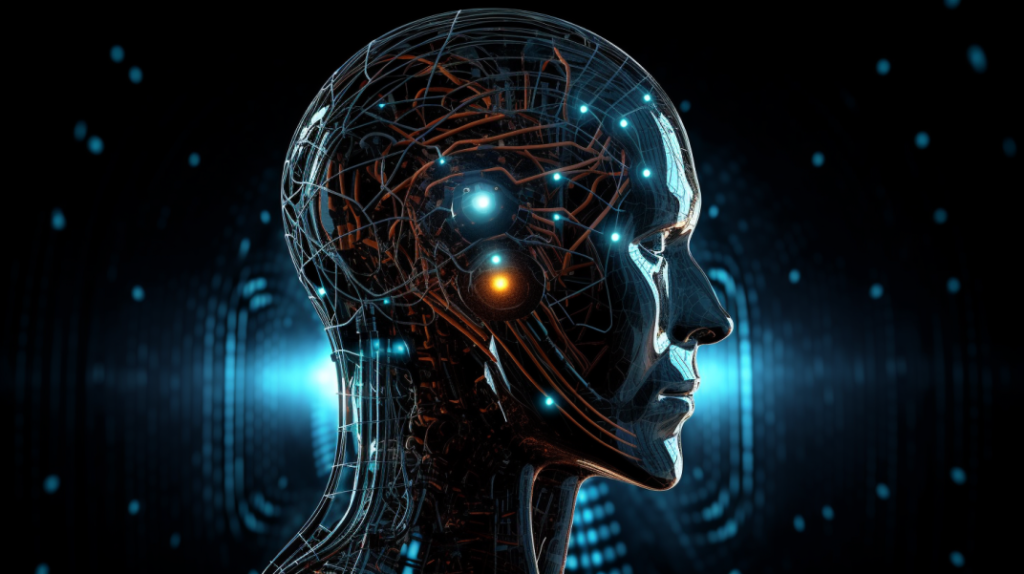Discover how AI merges with human brain tissue, reshaping tech and biology in a sci-fi reality. .In the unfolding saga of technology’s advancement, blending artificial intelligence with human brain tissue signifies a remarkable stage. As we enter this phase, a group of researchers, ethicists, and thinkers are tirelessly studying the merging of AI’s capabilities with the intricacies of human thought processes. This collaborative effort aims to deepen our comprehension of the brain’s complex functions and satisfy the desire for more individualized and empathetic interactions with technology.
The potential of this fusion is immense, possibly opening up new areas in medical science and improving the quality of life for people across the globe. As a society, we’re on the cusp of a new era where our inherent human experiences play a crucial role in AI development. It’s setting the stage for a future where technology truly grasps and augments the human condition. This pursuit is not just about creating advanced tools or gadgets; it’s about making a positive and meaningful difference in people’s lives.
As an AI researcher once said, ‘We’re not just creating technology for technology’s sake. We’re looking to make a tangible difference in the world. We’re building a future where technology understands us, not the other way around.’ This statement perfectly encapsulates the direction we’re heading in, and it’s a future full of promise and potential.
Key Takeaways: AI Merges With Human Brain
Integrating artificial intelligence (AI) with human brain tissue marks a significant moment for both tech and neuroscience. This step forward opens the door to fresh possibilities in studying behavior, learning, and crafting personalized solutions. But it’s not all plain sailing – we face serious hurdles in areas like ethics, cybersecurity, and even how we perceive our own identities.
The goal is to guide this technology in evolving responsibly. This involves rigorous oversight and shaping a structure that upholds human dignity and privacy. As AI and humanity become more intertwined, we are challenged to reassess societal norms and constructs.
This isn’t merely a technological disruption but a reevaluation of our human identity in an increasingly dynamic world.
The AI Development Surge

In the rapidly expanding field of artificial intelligence, scientists are making new strides by attempting to fuse AI with human brain tissue (AI Merges With Human Brain). This approach may lead to a breakthrough, where AI learning improves significantly, not just gradually, but also potentially at a rapid pace.
This unique combination of organic and digital thinking has the potential to reveal patterns in neural activity that have previously eluded AI algorithms.
As the collective of artificial and human intelligence expands, it opens up a new era of comprehensiveness where AI is more capable of grasping the complexities of human behavior and experience.
The potential results of such a merger are immense, creating a new narrative of collective intelligence that has the potential to broaden the boundaries of technology and society.
Human Brain Integration


The field of human brain integration is witnessing remarkable work. Scientists are leading the way in merging biological neural networks with artificial intelligence systems, aiming to improve cognitive processing capabilities. This combination could lead to substantial cognitive improvements.
Yet, fusing human cognition with AI technology raises significant ethical questions. This fusion begs a careful study of consent protocols, privacy rights, and the possibility of infringing on personal identity. As we intertwine our neural essence with digital elements, there’s a public demand for reassurance that this integration respects human dignity and freedom.
We must ensure that as we advance in this novel direction, we also strengthen the ethical barriers that protect our shared values and collective well-being.
AI Merges With Human Brain: Enhancing AI Learning


AI Learning and the Human Brain Connection
Recent studies in the field of artificial intelligence are showing promising strides in merging elements of human brain networks with AI systems. The goal of this progressive technique is to augment AI’s ability to learn. This is accomplished by mimicking the highly intricate and effective methods our brains use to process information, paving the way for a fresh model of brain-inspired learning.
By studying complex patterns of brain activity and replicating neural networks, AI can gain a deeper comprehension of human behavior. This could result in AI applications that are more responsive and in tune with human needs and actions.
As progress continues in this field, fostering a sense of unity among those involved is of utmost importance. It’s vital that these advancements align with and reflect shared values, and that they contribute to the overall good of society.
To put it succinctly, ‘The combination of artificial intelligence and human brain networks offers a promising future for machine learning, leading to more intuitive and adaptive AI applications.’
Understanding Human Behavior
The intricate nature of human behavior is a fascinating subject to study, and the potential of artificial intelligence (AI) working in harmony with brain tissue offers a promising path toward deepening our knowledge of cognitive functions and decision-making. This partnership can serve as a valuable tool for understanding the complexities of human psychology, especially in terms of its effects on mental health.
The influence of AI in decision-making procedures is set to expand, providing not just accurate but also anticipatory findings. By examining neural activity, AI can spot trends in behavior and indicators of mental health, thus promoting a sense of community through tailored care. Forward-thinking developments in this field could lead to significant progress in recognizing and addressing psychological disorders, promoting total wellness, and redefining societal perceptions of mental health.
Personalized AI Solutions
The fusion of data from the human brain with AI technology is leading to highly personalized offerings that can adjust to individual psychological profiles. By incorporating neural patterns, AI applications are moving away from blanket solutions, indicating a significant change in healthcare. In this scenario, treatment and monitoring are custom-made to suit each patient’s unique cognitive and emotional composition. This exactness promotes a feeling of inclusion, as individuals get care that aligns with their personal experiences and requirements.
AI-powered platforms are being crafted to interpret and react to subtle human behaviors, creating an empathetic and well-adjusted bridge between technology and the human mind. As this technology advances, it can change not only healthcare but also other sectors like education and customer service, where understanding the individual is the foundation of success.
In the words of a noted expert, ‘The future of AI offers a personalized approach, where technology adapts to humans, not the other way around.’
Ethical Challenges
The ethical implications of incorporating human brain data into AI systems are profound, particularly in the fields of healthcare and other industries. This approach opens up a world of customization possibilities but also brings significant ethical dilemmas to the forefront. One of the most pressing concerns is about privacy, as highly sensitive personal brain data could be exposed or misused within vast data networks.
Issues surrounding consent also come to the fore. Questions arise about the boundaries and nature of permission needed to use human neural patterns. As a society, we need to have serious ethical conversations to set up rules that protect individual rights and data ownership.
As those responsible for this merging of technology and biology, we must foster an atmosphere where trust and technological advancement can coexist. We must protect the intimate brain patterns that make us uniquely human, ensuring they remain secure as we move forward. This is a balancing act of the highest order, and we must tread carefully.
As the great Albert Einstein once said, ‘Technological progress is like an axe in the hands of a pathological criminal.’ We must ensure that this axe is wielded responsibly, with respect for the sanctity of our innermost selves.
Data Security Concerns
The incorporation of data derived from the human brain into artificial intelligence systems brings about serious data security issues. These issues need detailed attention to avoid any unauthorized access or misuse. When we consider the integration of AI with brain cells, the privacy stakes are high. Personal neurological data, which could contain sensitive details, becomes a hotspot for cyber threats.
A strong set of regulations needs to be in place in this innovative field to protect individual rights and uphold public faith. The challenge for all of us is to create a space where careful data management and innovation can live together, ensuring the integrity of this novel integration.
AI-Human Boundaries
Each step forward that brings artificial intelligence (AI) closer to interacting with human brain tissue makes the line between artificial and biological thought less evident. The blending of AI with brain matter brings up deep questions about AI awareness and what that means ethically.
As we move through this unique situation, it’s essential to think about the moral aspects of such technology.
The combination of natural and electronic intelligence could change how we see consciousness, calling for a broad conversation that aligns with our collective desire for community and shared principles. Additionally, the possible emergence of a mixed consciousness forces us to reconsider the limits of individuality and self-determination.
So, as we find ourselves on the brink of a new era of cognition, we must proceed with caution, keeping the innovation balanced with the seriousness of its ethical implications. It’s a fascinating topic that needs careful consideration and open conversation.
As we progress, we must remember to constantly check our moral compass and ensure that our actions align with the greater good. ‘In the quest for innovation, we must never lose sight of our shared humanity and the values that bind us.’
Future Societal Impact
The advent of brain-computer interface technology brings about significant societal changes, altering everything from the manner of medical treatments to daily interactions between humans and machines. As we witness the integration of AI with human brain cells, this blend doesn’t just push the boundaries of our abilities. It also stirs up discussions on consciousness, challenging our core understanding of sentience.
Looking at the employment sector, the impacts are two-fold. On one aspect, the improved cognitive abilities offered by AI could render routine jobs obsolete, necessitating a rethink of our occupational structures. Conversely, it also brings the potential for creating new job opportunities focusing on the collaboration between humans and AI.
As we step into this unexplored domain, fostering a shared sense of ethics becomes a priority. We must ensure that the development of AI contributes positively to our shared human experience rather than detracting from it.
To quote a thought leader in this field, ‘The intersection of humans and AI is not just about technology. It’s about enhancing our collective human experience.’
Conclusion
The merging of artificial intelligence with human brain tissue signifies a turning point for both technology and the field of neuroscience. This development opens up new horizons in learning, behavior analysis, and the creation of tailor-made solutions. However, the advancement doesn’t come without its challenges, which are deep and varied, touching upon ethics, security, and even our perception of identity.
The task at hand is to ensure that this technology evolves responsibly. This means applying strict scrutiny and developing a framework that respects human dignity and privacy. As the lines between artificial intelligence and humanity continue to blur, we find ourselves in a position where we must redefine societal norms and constructs.
This shift is not just about technology, but about how we see ourselves as humans in a rapidly changing world



